Types of Conflict Worksheets
What would a story be without a conflict? It would be boring. Perhaps that is why all stories worth telling have a problem. Most scholars agree that there are six basic types of conflicts in literature. I will define each of these. Then I will provide PowerPoint lessons and worksheets that reinforce these ideas. Use these resources to help your students master the concept of conflict in literature.
Person Versus Person
In this type of conflict, the central character clashes with another person. It doesn't always have to be a person. They could be animals for instance. I guess It's just easier to say person instead of entity.
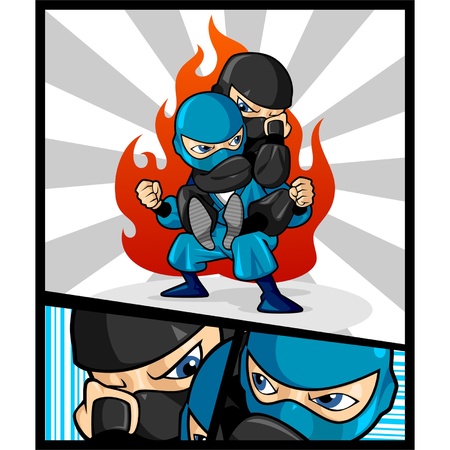
Person Versus Self
When a story has a person vs. self conflict, the main character battles him or herself. He or she may lack confidence or ability. He or she may have to make a difficult choice. Or he or she may have to address a personal problem. The key here is that the battle occurs within the character, though it may involve and affect other characters.
Person Versus Society
With this type of conflict, the main character challenges a law, tradition, or institution. The main character or characters may battle against the forces that represent these institutions.
Person Versus Nature
When a story has a person vs. nature conflict, the main character fights to endure or overcome forces of nature. He or she may struggle to survive harsh elements, navigate through a disaster, or meet his or her basic needs. Stories with this type of conflict may occur in the wilderness often, but they can occur in urban settings too.
Person Versus Supernatural
In stories with this type of conflict, the main character resists forces that are not of this world. He or she may battle monsters or strange creatures. He or she may challenge beings with magical powers. Or he or she may encounter hostile aliens. The key to this conflict is that forces that are not of this world threaten the main character.
Person Versus Technology
In a story with this type of conflict, the main character resists technological forces. He or she may battle rouge robots or hostile computers. Or he or she may just struggle to accept or use the technology of a changing world.
Worksheets and Lessons
These worksheets and PowerPoint lessons are great for reinforcing this information. Worksheet files are saved in RTF (for editing) and PDF (for printing) format. Feel free to modify or change the content on these worksheets for use in your classroom. They are also available as preview files and the answer keys are included in web format as well.
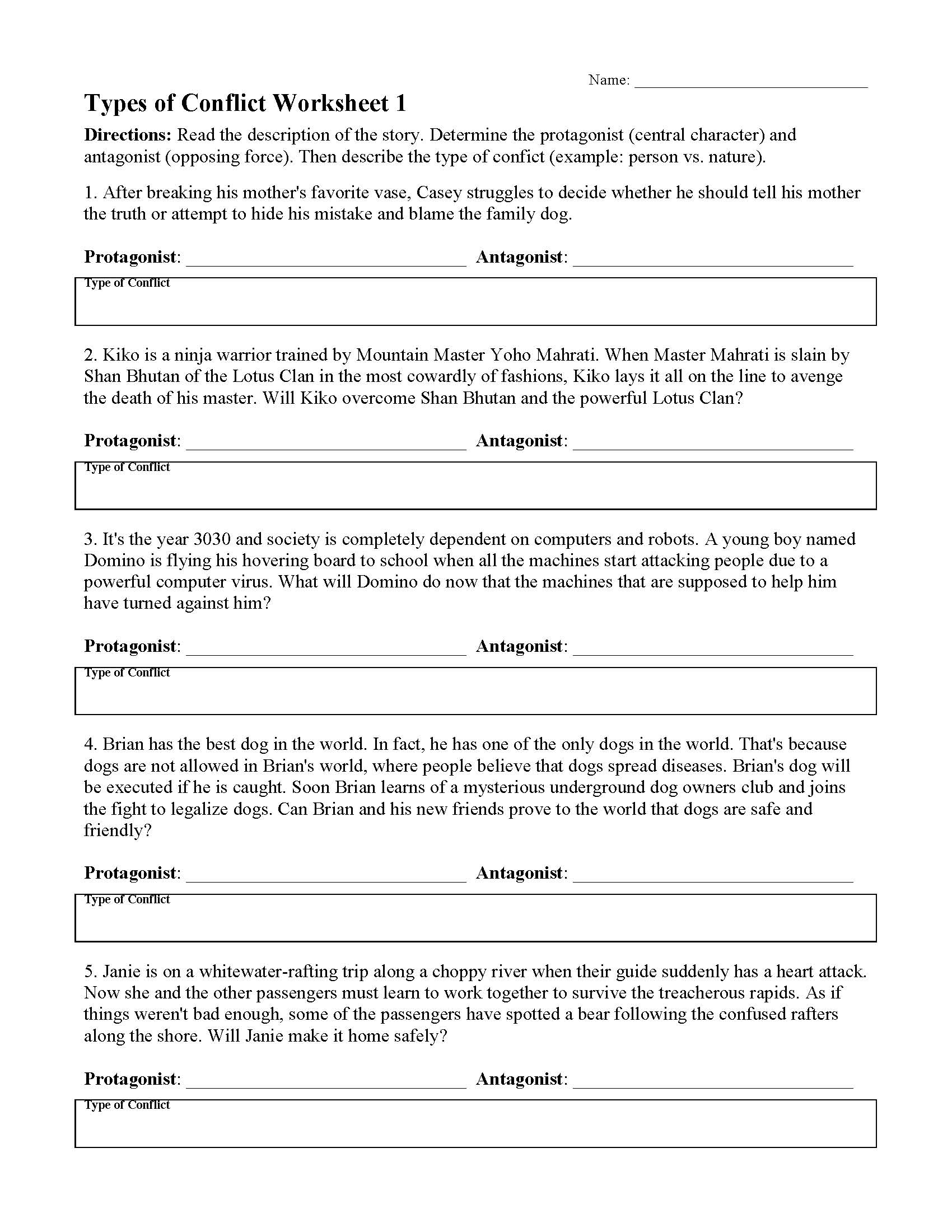
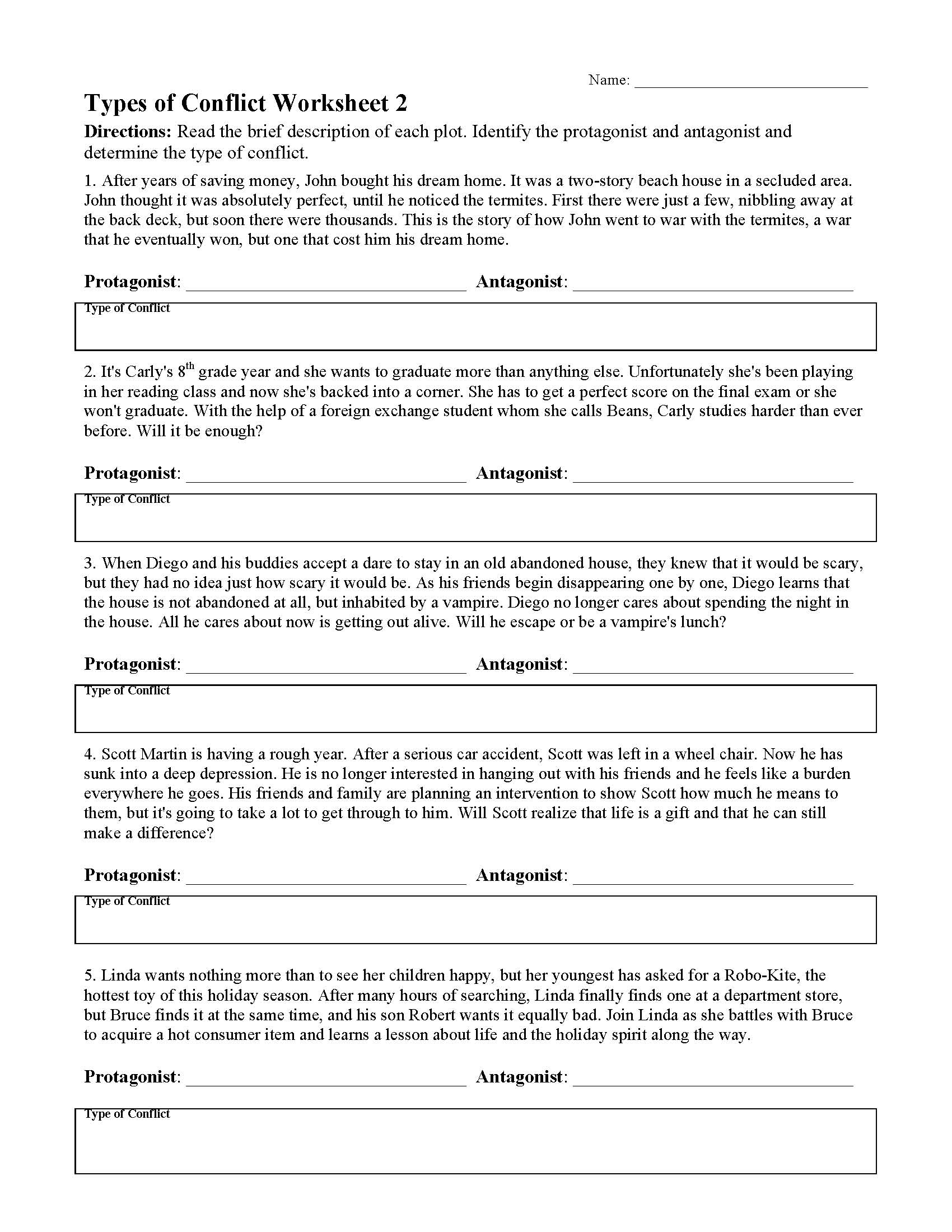
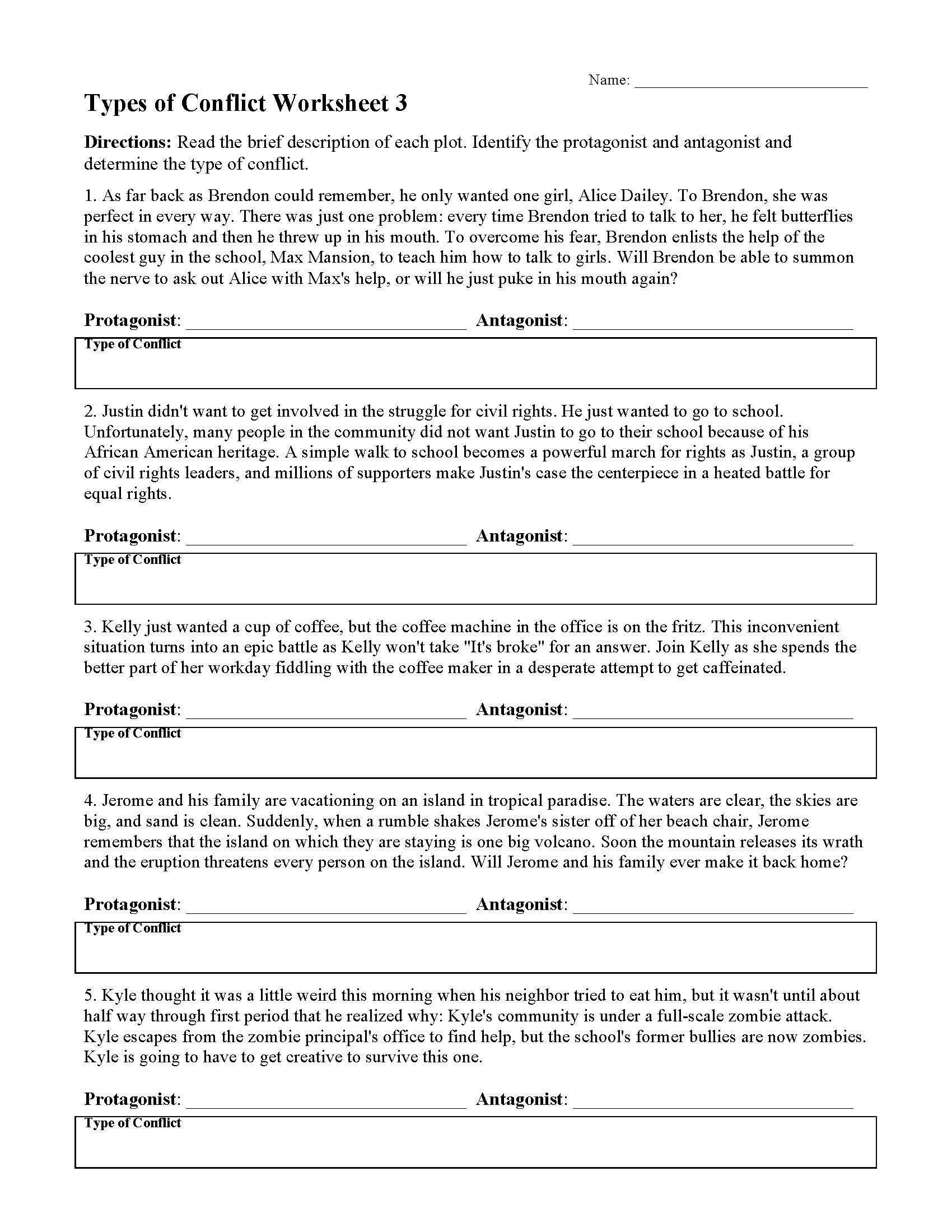
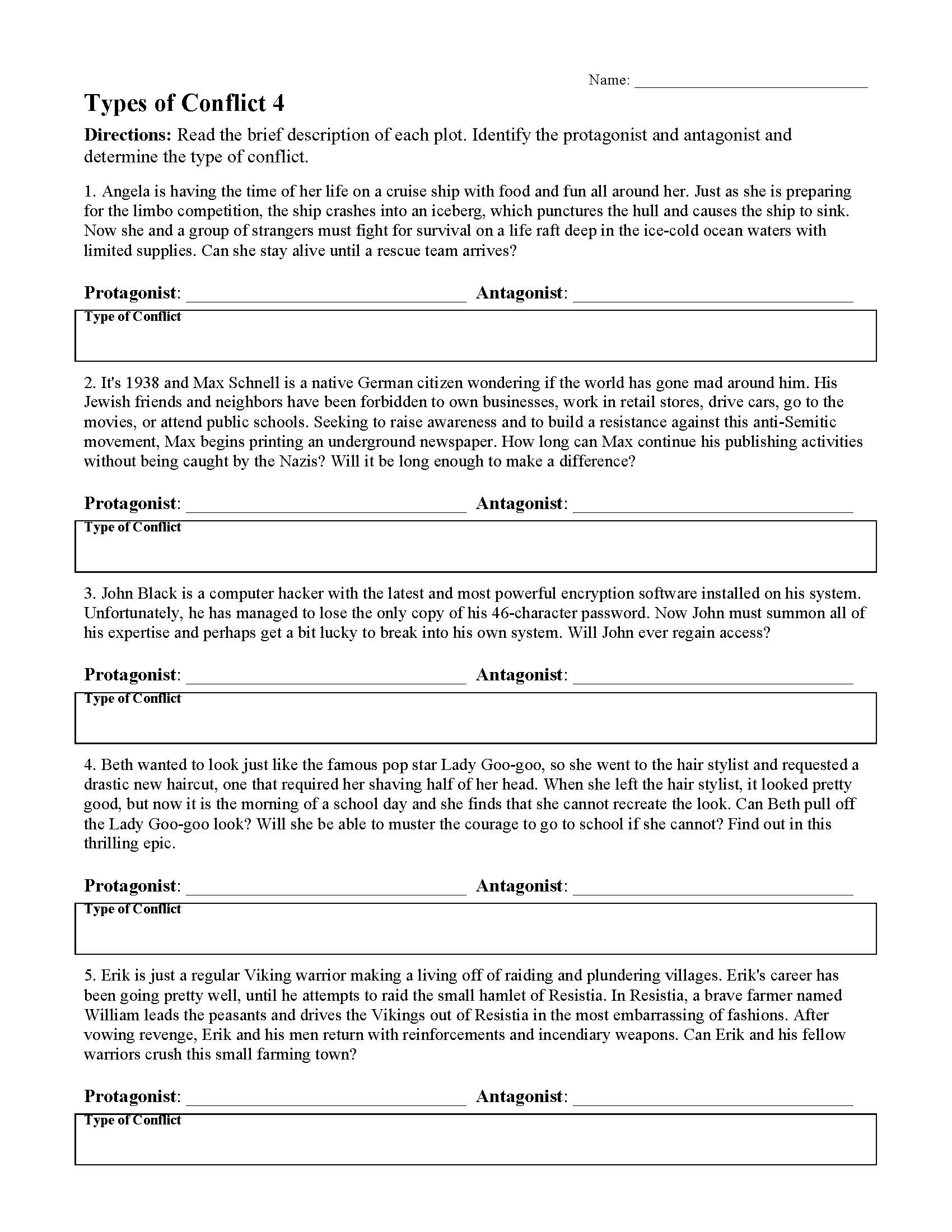



Literary Conflict
Common Core State Standards
RL.K.3 - With prompting and support, identify characters, settings, and major events in a story.
RL.1.3 - Describe characters, settings, and major events in a story, using key details.
RL.2.3 - Describe how characters in a story respond to major events and challenges.
RL.3.3 - Describe characters in a story (e.g., their traits, motivations, or feelings) and explain how their actions contribute to the sequence of events.
RL.4.3 - Describe in depth a character, setting, or event in a story or drama, drawing on specific details in the text (e.g., a character's thoughts, words, or actions).
RL.5.3 - Compare and contrast two or more characters, settings, or events in a story or drama, drawing on specific details in the text (e.g., how characters interact).
RL.6.3 - Describe how a particular story's or drama's plot unfolds in a series of episodes as well as how the characters respond or change as the plot moves toward a resolution.
RL.7.3 - Analyze how particular elements of a story or drama interact (e.g., how setting shapes the characters or plot).
RL.8.3 - Analyze how particular lines of dialogue or incidents in a story or drama propel the action, reveal aspects of a character, or provoke a decision.
RL.9-10.3 - Analyze how complex characters (e.g., those with multiple or conflicting motivations) develop over the course of a text, interact with other characters, and advance the plot or develop the theme.
RL.11-12.3 - Analyze the impact of the author's choices regarding how to develop and relate elements of a story or drama (e.g., where a story is set, how the action is ordered, how the characters are introduced and developed).
Search here.
36 Comments
Leave a Reply
- Author's Purpose Worksheets
- Characterization Worksheets
- Conflict Worksheets
- Fact and Opinion Worksheets
- Figurative Language Activities
- Figurative Language Poems with Questions
- Genre Activities
- Irony Worksheets
- Making Predictions
- Mood Worksheets
- Nonfiction Passages and Functional Texts
- Parts of Speech Worksheets
- Poetic Devices
- Point of View Worksheets
- School Project Ideas
- Setting Worksheets
- Simile and Metaphor Worksheets
- Story Structure Worksheets
- Text Structure Worksheets
- Theme Worksheets
- Tone Worksheets
- ALL PAGES AND WORKSHEETS




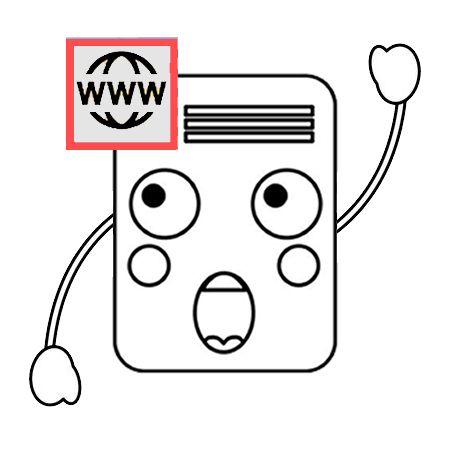


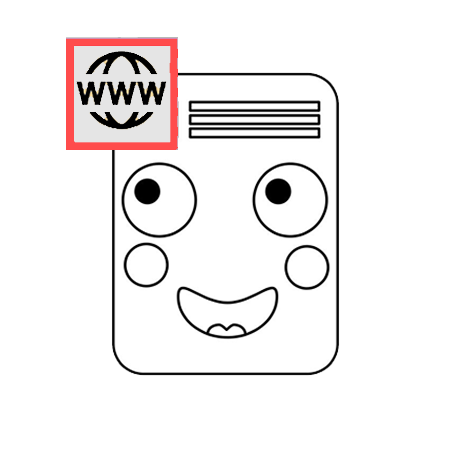
Abby
/ July 25, 2023Thank you for your generous help with the rich resources! I’m really benefited from these worksheets. I am thinking of donating money to this website. How can I have this access?
Mr. Morton
/ October 26, 2023Don’t worry about it. The site is supported by ads. Best wishes and thank you for thinking of me!
AK
/ May 17, 2023I just stumbled across this website and I just wanted to say THANK YOU! This is absolutely amazing. Thank you for sharing this material.
S O'Dell
/ April 14, 2023PLEASE FIX THESE ERRORS ON YOUR WEBSITE. THANK YOU!!!
You have misspelled the word rogue as rouge (the red stuff you put on your cheeks). Also the sentence that says:
Now Vanessa, her art teacher are going to fight for the freedom of expression.
It should be fixed to say: Now Vanessa and her art teacher are going to fight for the freedom of expression.
JULIETTE ABTAHI
/ November 6, 2023I think that if you find a wonderful, FREE resource such as this you shouldn’t be looking the gift horse in the mouth.
Just my opinion.
M
/ February 20, 2022I just found this website so I haven’t see all it holds, but I still really want to thank you for all of this! I really love how you have skills as categories-amazing- I’ve never seen that before anywhere. Thank you.
Ifeanyi
/ November 13, 2020This website is helpful thanks and it’s free i appreciate it
Akhil
/ January 27, 2020This website is really good. Thank you for making this and well done.
San Diego Homeschool mom
/ January 26, 2020Dear Mr. Morton,
thanks you so much for your resources. You make things so clear I am able to teach higher concepts to two boys and they understand it. They will be be ahead of the game when they get into middle and high school.I hope you keep writing your worksheets as you are very talented at making clear points so that even old moms can get it! I can’t believe I just found this- I’ve been homeschooling for 12 years and I wish I had this years ago. Thanks so much for being so giving..
San Diego Homeschooling mom
Joe
/ August 15, 2019How can I verify that the answers are correct?
shellie mcallister
/ September 4, 2019he provides an answer document for everything. look below the link for each assignment and you will see it
Kimberly Arnold
/ March 28, 2019I cannot express my gratefulness for this website and resource. I am an intervention specialist/special educator on her own special ed. island, and I have to present all core content regardless of the fact that ELA is my only specific area of focus. Whereas ELA is my first love, I feel like I skimp on planning because every other subject requires so much of my attention because I’m learning as a go along. This resource is saving lives, and I am so grateful for the quality.
Mr. Morton
/ April 1, 2019Thanks for using my site and taking the time to comment. It is inspirational. Thank you.
jennifer
/ October 23, 2018These are so helpful! I have a question though, how would you explain internal v.s. external conflicts ?
Mr. Morton
/ October 24, 2018Internal conflicts occur within a character. This may take the form of a difficult decision or complex emotions. External conflicts occur outside of a character. There are more forms of external conflicts, so I’m not going to attempt to list them all.
Thanks for visiting my site!
Evelyn
/ March 30, 2017Hello, I’m Evelyn :Thank you so much for this information and resources I am a grandmother who is raising my granddaughter and a lot of what they are teaching now is somewhat indepth of what I learned. This helps me teach her just what is needed. Again thank you!
Evelyn
/ March 30, 2017Hello I’m Evelyn and I want to “Thank You” for these resources. It is just what I needed to teach my granddaughter diverse levels and traits of reading and some of them I have forgotten. This has allowed me to gather sources that is much needed and useful! Again “Thank You!!!”
Mr. Morton
/ March 30, 2017You are so welcome. I’m sure that you are doing wonders for your granddaughter.
Sandie
/ March 4, 2017Thank you so much for these resources. You are a life saver!
kayen
/ January 11, 2017nice job!
Melissa
/ December 13, 2016This website is amazing!!! I have a reading midterm tomorrow and it helped me to recap what i’ve learned.
Wendy
/ November 17, 2016You have great resources! Thank you for sharing your talents!
Maqsood Alam
/ October 18, 2016What is the need of conflict in Drama.
Mr. Morton
/ March 30, 2017A story without conflict is not much of a story.
Annette Goldstein
/ May 9, 2016This website has a elaborate and very detailed genre of concepts. I am using it on a daily basis. What a phanominal resource.
Mr. Morton
/ May 18, 2016Thank you so much for saying so.
Kevin
/ March 27, 2016To be honest, I love what you are doing but disagree with the last 3. I believe they would all fall under ‘Person vs Environment’. Great work though!
Kevin
/ March 27, 2016Just to elaborate. This involves the environment or context changing and becoming hostile towards the protagonist (and others).
Johnny Simpson
/ February 26, 2016I am using this amazing website on a daily bases, and I love it, but the only problem is that your website needs more problems.
Thank you
Mr. Morton
/ March 15, 2016I’m working on it, but everything takes time.
David Vazquez
/ December 2, 2015I need some kind of test template.
Mr. Morton
/ December 2, 2015Here’s a test template that I’ve been using. I hope that it helps!
Promee Mahbub
/ June 27, 2015When you steal something it is a conflict because you are doing something wrong. Is this right or wrong
Mr. Morton
/ June 29, 2015It’s all about how the author develops it. For example: Character feels bad about him or herself and steals a fashionable pair of pants… maybe internal conflict? Character steals a controversial flag, gets caught, and faces a trial… person versus society? Character wants to injure another character, so he or she steals the other character’s important possession… person vs. person. An action alone is not a conflict. The conflict is more than a single action. The conflict is developed by the author in a way that is central to the story.
bamlaku
/ November 15, 2014how the character conflict with a technology?
Mr. Morton
/ November 19, 2014Like, maybe giant robots are trying to take over the Earth. Or, as a more mundane example, maybe Grandpa cannot figure out how to work his phone.